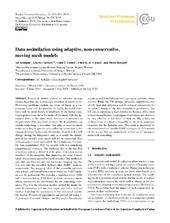| dc.contributor.author | Aydogdu, Ali | |
| dc.contributor.author | Carrassi, Alberto | |
| dc.contributor.author | Guider, Colin T. | |
| dc.contributor.author | Jones, Chris K.R.T. | |
| dc.contributor.author | Rampal, Pierre | |
| dc.date.accessioned | 2020-08-05T09:30:04Z | |
| dc.date.available | 2020-08-05T09:30:04Z | |
| dc.date.issued | 2019 | |
| dc.Published | Aydogdu A, Carrassi A, Guider, Jones CK, Rampal P. Data assimilation using adaptive, non-conservative, moving mesh models. Nonlinear processes in geophysics. 2019;26(3):175-193 | eng |
| dc.identifier.issn | 1023-5809 | en_US |
| dc.identifier.issn | 1607-7946 | en_US |
| dc.identifier.uri | https://hdl.handle.net/1956/23439 | |
| dc.description.abstract | Numerical models solved on adaptive moving meshes have become increasingly prevalent in recent years. Motivating problems include the study of fluids in a Lagrangian frame and the presence of highly localized structures such as shock waves or interfaces. In the former case, Lagrangian solvers move the nodes of the mesh with the dynamical flow; in the latter, mesh resolution is increased in the proximity of the localized structure. Mesh adaptation can include remeshing, a procedure that adds or removes mesh nodes according to specific rules reflecting constraints in the numerical solver. In this case, the number of mesh nodes will change during the integration and, as a result, the dimension of the model's state vector will not be conserved. This work presents a novel approach to the formulation of ensemble data assimilation (DA) for models with this underlying computational structure. The challenge lies in the fact that remeshing entails a different state space dimension across members of the ensemble, thus impeding the usual computation of consistent ensemble-based statistics. Our methodology adds one forward and one backward mapping step before and after the ensemble Kalman filter (EnKF) analysis, respectively. This mapping takes all the ensemble members onto a fixed, uniform reference mesh where the EnKF analysis can be performed. We consider a high-resolution (HR) and a low-resolution (LR) fixed uniform reference mesh, whose resolutions are determined by the remeshing tolerances. This way the reference meshes embed the model numerical constraints and are also upper and lower uniform meshes bounding the resolutions of the individual ensemble meshes. Numerical experiments are carried out using 1-D prototypical models: Burgers and Kuramoto–Sivashinsky equations and both Eulerian and Lagrangian synthetic observations. While the HR strategy generally outperforms that of LR, their skill difference can be reduced substantially by an optimal tuning of the data assimilation parameters. The LR case is appealing in high dimensions because of its lower computational burden. Lagrangian observations are shown to be very effective in that fewer of them are able to keep the analysis error at a level comparable to the more numerous observers for the Eulerian case. This study is motivated by the development of suitable EnKF strategies for 2-D models of the sea ice that are numerically solved on a Lagrangian mesh with remeshing. | en_US |
| dc.language.iso | eng | eng |
| dc.publisher | Copernicus | en_US |
| dc.rights | Attribution CC BY | eng |
| dc.rights.uri | http://creativecommons.org/licenses/by/4.0/ | eng |
| dc.title | Data assimilation using adaptive, non-conservative, moving mesh models | en_US |
| dc.type | Peer reviewed | |
| dc.type | Journal article | |
| dc.date.updated | 2020-02-10T15:36:40Z | |
| dc.description.version | publishedVersion | en_US |
| dc.rights.holder | Copyright 2019 The Authors | en_US |
| dc.identifier.doi | https://doi.org/10.5194/npg-26-175-2019 | |
| dc.identifier.cristin | 1721709 | |
| dc.source.journal | Nonlinear processes in geophysics | |

